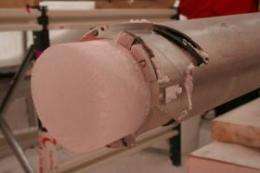New research closes the gap between warming and rising carbon dioxide

Scientists have shed new light on one of the most important questions in climate science: the time lag between changes in temperature and changes in atmospheric carbon dioxide levels in the past.
Their findings suggest that feedbacks in the climate system – in which warming is linked to natural carbon dioxide increase, driving further warming – may operate faster than previously thought.
In a paper published overnight in the journal Climate of the Past, the researchers use Antarctic and Greenland ice cores to examine temperature and carbon dioxide changes during the largest natural climate change in Earth's recent climate history: the warming out of the last ice age.
As Antarctic temperatures increased ocean circulation was altered and carbon dioxide, most likely from the deep Southern Ocean, was releasedto the atmosphere. Previous studies had suggested that it took up to 1000 years for this to happen. But the new study, drawing on data from five separate ice cores, whittles that figure down.
"The ice cores reveal a near-synchronous temperature and carbon dioxide increase. If there was a lag at all then it was likely no more than 400 years,” says Joel Pedro from the Antarctic Climate and Ecosystems CRC, in Hobart, who led the study.

Eric Steig, an American ice core expert based at the University of Washington who examined Pedro’s PhD thesis, said almost all previous work had provided uncertainties on the time lag between temperature and carbon dioxide in the order of many hundreds to even thousands of years. “I cannot emphasize enough how important this result is,” he said. “The authors collapse these values to something so short that it has major implications for our understanding of the carbon cycle and climate change."
Beginning about 19,000 years ago, the extensive ice sheets covering Canada and Northern Europe began to melt back. The initial warming was likely triggered by cyclic variations in the geometry of the Earth’s orbit. Over the next 8000 years atmospheric carbon dioxide levels increased by close to 50%, helping to drive an eventual global average temperature increase of 5°C and a sea-level rise of over 100 m.
Resolving the sources and processes responsible for the carbon dioxide increase has been a longstanding puzzle. The new results support hypotheses linking the increase to rapid hemispheric-scale reorganisations of ocean and atmospheric circulation moving carbon dioxide from the deep Southern Ocean to the atmosphere around Antarctica.
Pedro says that there are similarities but also important differences between current climate change and the natural processes described in their research.
“The coupled rise in temperature and natural increase in carbon dioxide that helped end the ice age took place gradually, over about 8000 years. What we have seen since the start of the industrial revolution is a similar carbon dioxide increase occurring over only a few hundred years. This is way faster than anything in the ice core record and it’s clearly human-caused. Just as the steady increase in carbon dioxide helped to melt the ice caps and warm the Earth out of the ice age, the rapid increase now in carbon dioxide is also driving up temperatures, only at a much faster rate,” he said.
An important question arising from the study is whether current anthropogenic warming may drive additional natural carbon dioxide increases sooner than we thought, compounding the climate change problem. Dr Pedro acknowledges that the research raises this possibility, but cautions that a firm answer on whether we need to revise thinking on the timescales of carbon cycle response to anthropogenic warming requires further research.
The research is part of an ongoing collaboration between Joel Pedro (ACE CRC), Tas van Ommen (Australian Antarctic Division, ACE CRC) and Sune Rasmussen (Niels Bohr Centre for Ice and Climate, Copenhagen, Denmark).
Temperature and carbon dioxide graph
The Antarctic temperature curve (green) is based on data from 5 near-coastal ice cores, and the carbon dioxide records are from Byrd (red) and Siple Dome (blue). The data reveal that the time-lag between past temperature increase and past carbon dioxide increase was much smaller than previously thought: the increase in carbon dioxide likely lagged the increase in regional Antarctic temperature by less than 400 years and even a short lead of carbon dioxide over temperature cannot be excluded.
More information:
www.antarctica.gov.au/__data/a … CP-Pedro-CO2-lag.pdf
Provided by Australian Government